SAP Enabling the Greenfield Digital Refinery of the Future
1. Forward
Disclaimer: The views and opinions outlined in this blog reflects solely the point of view of the author and not SAP
Various recent reports forecast that the global crude refining capacity will witness strong growth in the next five years. China, Southeast Asia, Latin America and the Middle East will lead the refinery growth.
The most conservative report predicts a 9.4 mb/d addition in global capacity by 2020, whereas the most aggressive report expects an addition of 25 to 28 mb/d in the next five years.
Though global demand is projected to increase in 2017, the refining capacity is increasing at a faster pace. New refineries are being added to cater to the local demand, which is expected to increase the supply glut of refined gasoline, diesel, jet, and shipping fuel. (1)
1.1 Blog Purpose and Structure
The purpose of this blog is to outline the SAP vision (from author’s perspective) for the digital energy revolution and how SAP integrated industry solution can empower Greenfield refineries throughout their journey from design through build and ultimately during operation.
The way this blog is outlined is to first provide explanation of SAP’s vision for Digital Oil and Gas Companies, then highlights what process engineering leaders envision for refineries of the future, followed by the Greenfield refinery context from an SAP perspective and how SAP is perfectly positioned to support our customers throughout their design, build and operate journey. The final sections of the blog will outline the bases for taking the right decision for business solutions selection comparing best of breed to integrated approach, a high level sample architecture and a conclusion.
Although this write up is intended for refineries, the Greenfield value realization is applicable for petrochemicals, process manufacturing as well as other asset intensive industries.
2. How SAP is Insprining and Shaping the Digital Energy Revolution
2.1 Background
During periods of extreme price volatility, oil and gas companies must become resilient by maximizing capital and operational efficiency using digital technologies, automating tasks, remotely monitoring assets, and more. It will be these digitally-enabled companies that are most able to diversify their energy portfolios in order to maintain and grow market share.
True industry leaders will go even further, seeking out new ways to create value for customers by innovating new energy services. To deliver these services, they will need to shift away from traditional, vertically-integrated business models dependent on control of resources and assets – and embrace “asset-less”, collaborative, networked business models, processes, and ways of working.
Digitalization will make this possible. Companies can connect business processes and join together these connected processes across the value chain through a digital network. These digitally-integrated energy companies will specialize and differentiate through execution excellence.
Digital advances such as hyper-connectivity, supercomputing, cloud computing, smart technology, the Internet of Things, and cyber-security are challenging the status quo in every industry. Leading energy companies are responding to these challenges by leveraging these advances to:
Re-imagine business models where they either specialize within, orchestrate across, or create new business models and services
Re-imagine business processes and use digital technology to integrate, collaborate and automate across enterprises, focusing on optimizing business outcomes
Re-imagine the roles and ways of working that exploit new digital technology, such as wearables, 3D printing, augmented reality and machine learning technologies
2.2 The SAP Vision
At SAP, our vision is to help the world run better and simpler by helping oil and gas companies to deliver the safe, reliable, and affordable energy needed to support modern lifestyles and provide opportunities for people. To realize this vision, we provide the digital foundation needed to connect all stakeholder enabling them to thrive within the emerging digital energy network. (2)
The below diagram illustrates what is at the heart of a digital energy network. The idea is very simple – bringing together transactions and analytics on the same platform – but it took years to make it a reality. Uniting structured data (such as finance data) and untrusted data (such as text, video, and voice) will change the way energy companies plan, scale, and innovate.
The innovation of in-memory computing started as a concept and was brought to life with the release of the SAP HANA technology platform. While SAP HANA is a relatively young technology by commercial standards, rapid adoption by oil and gas companies shows its massive potential value for the industry and digital businesses.
With in-memory computing, we can finally:
1. Leverage big data from meters, sensors, weather, social media, and geospatial systems. Analyzing all data signals together results in bigger insights and optimal recommendations, which can be instantly acted upon in transactional systems via human and machine-to-machine interfaces.
2. Extend business processes to interoperate with business partners in near real-time speeds using advanced, cloud-based business networks.
3. Modernize business processes from finance, supply chain, and enterprise asset management to meter-to- cash – all in real time without the need for data replication or batch programs.
These capabilities create infinite new ways of optimizing business, driving business digitization, simplifying everything, reducing costs, and gaining the agility needed to succeed in today’s fast-changing world.
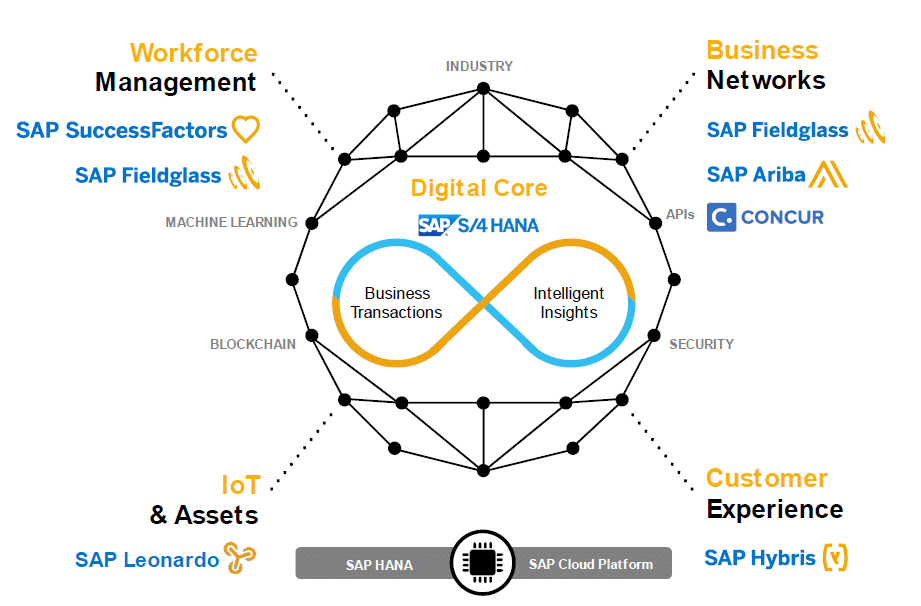
Advanced, in-memory computing puts an end to running your business in batch mode and eliminates complex workarounds for production, processing, distribution, and retail of crude oil and products.
Running in real time
Real-time optimization of business changes will have huge implications for how we work, do business, and organize.
The power of prediction and simulation
Every employee can access real business insights using simulation and predictive tools – insights that drive smarter decisions, improve reliability, and reduce outages.
Agility
To thrive in the digital economy, energy companies need the ability to rapidly enter new markets, acquire and onboard new utility business models, and reflect organizational changes in a tenth of the time required with current systems.
Deployment choice and lower TCO
Accessing solutions to run your core business has to be simple. Energy companies now have the choice to deploy in house or in the cloud. In-memory computing also has a significant impact on TCO and it will free up funds for infrastructure investment.
A consumer-grade user experience
A quality user experience is vital to helping people accept digital change. It drives adoption, user engagement, and the productivity of people.
SAP S4/HANA is the only end-to-end solution that covers all business processes and runs in-memory. It helps oil and gas companies run in real time for fundamentally better performance. SAP S4/HANA empowers Oil and Gas companies to a single, real-time actionable insights that covers all corporate domains from operation through back office to people
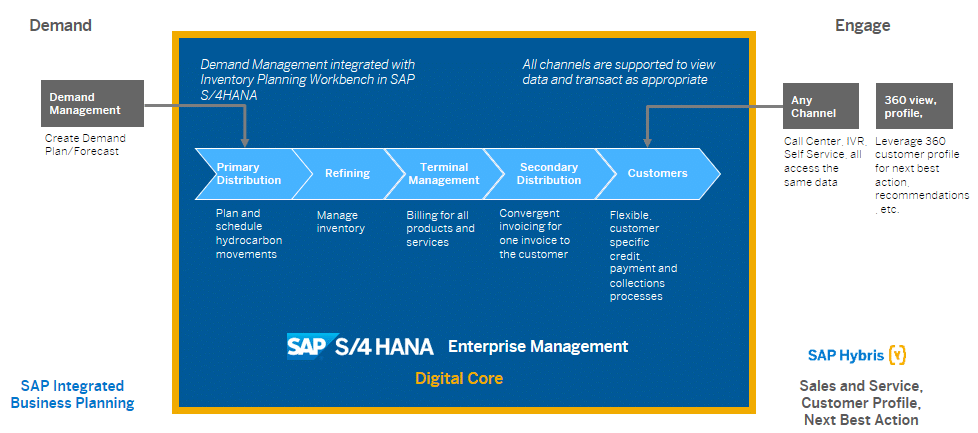
With IoT platform (SAP Leonardo), organizations can now take embedded device data, analyze this data into information in real time, and apply this information across the value chain to drive business insights and create new business models.
The Internet of Things edition of SAP HANA provides the connectivity to OT systems either directly or through partners like OSIsoft (link to OSIsoft partnership). The data is stored and processed in the platform, which provides basic functions like data services (such as operations on time series), predictive analytics, and others. Applications are developed by SAP, partners, and customers and enable use cases such as well performance management and predictive quality
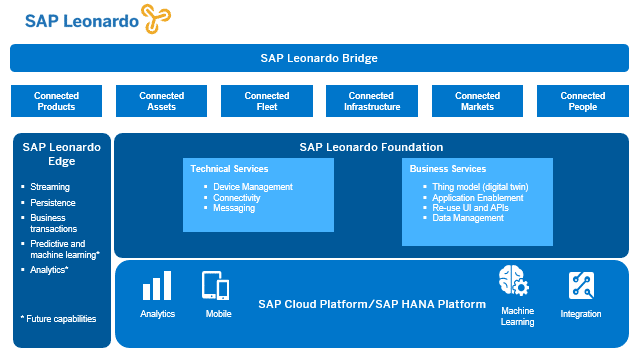
Next-generation business processes will span multiple pillars to drive efficiency internally or across the business network, connect to devices, and enhance the Omni channel customer experience.
Imagine that sensor data is continuously collected and analyzed in real time to measure and monitor asset status and health. This information is also fed into advanced analytics models that can predict impending asset failures early – in time for maintenance staff proactively take measures to avoid damages and outages. To determine proactive measures, the system needs to identify potential root causes for an expected failure and then recommend best actions – for example, this may involve ordering the right spare parts, assigning the right experts, and devising a cost-effective schedule.
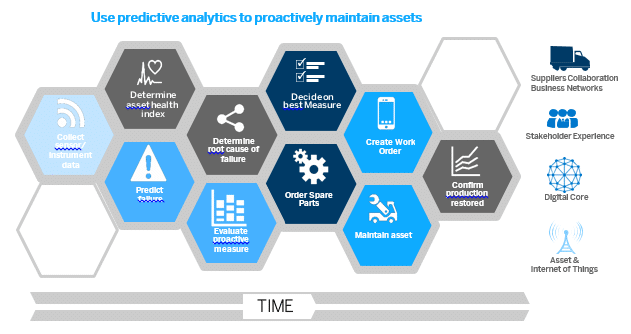
The digital work order dispatches the service crew and provides additional geospatial and device information to ensure that the right activities are conducted at the right time by qualified people, and with the right spare parts and tools.
Every outage and failure that can be prevented or proactively managed minimizes cost and maximizes asset availability and increases customer satisfaction.
In this context, real-time predictive analytics yields tangible business benefits such as:
• Higher return on assets
• Faster recovery time from failure
• Higher productivity and safer work
• Competitive service-level agreements
• Higher customer satisfaction
SAP Whitepaper: Digital Oil and Gas Company
3. The Digital Refinery – Envisioning the Refinery of the Future
Modern refineries make use of advanced digital automation via utilizing smart devices. Smart devices replace the “ear of a seasoned field operator or technician”. The current digital technology, embracing all of the real-time, online information and capabilities available from these smart instruments and systems
With information about asset health and performance more readily available, refiners can achieve safer and more reliable operations than previously experienced. Old single train refineries had around 20,000 I/Os. Modern refineries has around 50,000 I/Os (3)
Field instruments equipped with smart diagnostics alert about asset problems in real-time before they fail. Such diagnostics identify the root cause of the troubled asset, so maintenance can effectively correct the problem. This same root cause predictive diagnostics identify and plan for a smarter turnaround by repairing only the assets requiring work. The question of when to pull a piece of equipment for repair is a complex issue that should be based on its performance history,, the cost of repair and the risk and consequence of a failure
Refineries of the future must adopt and integrate innovations now, rather than take the wait-and-see approach. Prospering in the face of uncertainties often means challenging the status quo. Three primary operational and business goals can empower Greenfield customers to run the refinery of the Future:

Envisioning a “future-proof” refinery of the future: Marcelo Carugo, Director, Refining Solutions
4. How SAP Solutions Can Generate Substantial Value in the Digital Greenfield Refinery of the Future
With its Digital Core, industry focus as well as Information Technology/Operation Technology (IT/OT) convergence framework, SAP is very well positioned to address the three primary operational and business goals to run the refinery of the Future.
Agility: The central theme faced by virtually every company today is ambiguity. The only thing companies can do to adequately prepare is ensure that their organizations are as nimble and responsive as possible. This generally leads to an urgent need to simplify: Not just their IT landscape, but business processes, data structures and the way they do business entirely. This is where SAP S/4HANA enters the lime light as a new digital core. Customers are using SAP HANA in-memory technology to get closer in real-time to customers and suppliers, as well as production assets. They’re radically simplifying business processes for faster business outcomes using role-based data user interfaces like SAP Fiori. For IT, these technologies simplify the stack, lower total cost of ownership and increase agility
See: The Value of SAP HANA in Oil and Gas
Reliability: The world of oil and gas is dominated by physical assets. The industry is built on countless miles of pipe and millions of pumps, valves, and gauges. Sensor-enabled infrastructure and wireless connectivity offer oil and gas companies alternatives to costly field operations. SAP Asset Intelligence Network is a cloud based hub that facilitates collaborative asset management and provide operators with up-to-date maintenance strategies, manuals, and more from manufacturers – and manufacturers can automatically receive asset usage and failure data from operators
See: SAP Asset Network Solution
Sharing of Intelligence: The hydrocarbon value chain is at the heart of the downstream business, and today’s fragmented and often outdated IT landscape prevents oil and gas companies from unlocking all of the available value. SAP Connected Hydrocarbons Logistics unlocks this value by better managing changes in supply, demand and commodity prices. Connected Hydrocarbons deliver two key digital capabilities our customers are demanding: a real-time view of all their product inventories, and the ability to predict asset failures and prescribe their best sequence of repair. SAP co-innovate with oil and gas major players developing uses cases around use of drones and internet of things around assets inspection/surveillance.
See: SAP Hydrocarbon Supply Chain Solutions and Data Science and Machine Learning in the Internet of Things and Predictive Maintenance
In the Greenfield context, customers are faced with unique challenges/opportunities that SAP is best equipped to fully and efficiently address through teaming up with Greenfield refinery customers along the entire journey from project planning through design and execution/build to handover, commissioning and operation. The following section highlights major Greenfield challenges/opportunities.
4.1 Design, Build and Operate
From the day a new company has just been incorporated to manage a new refinery or the new refinery is just an initiative/idea, S4/HANA is the perfect fit to manage the core activities that include finance, procurement and project portfolio management. S4/HANA simplified technology stack brings in very appealing TCO with an unprecedented scalability to cover all business activities throughout the refinery build and operate journey.
If customer is not planning to have a datacenter or data center will not be ready before sometime, SAP and SAP partners can flexibly host and manage S4/HANA either short-term or longer term
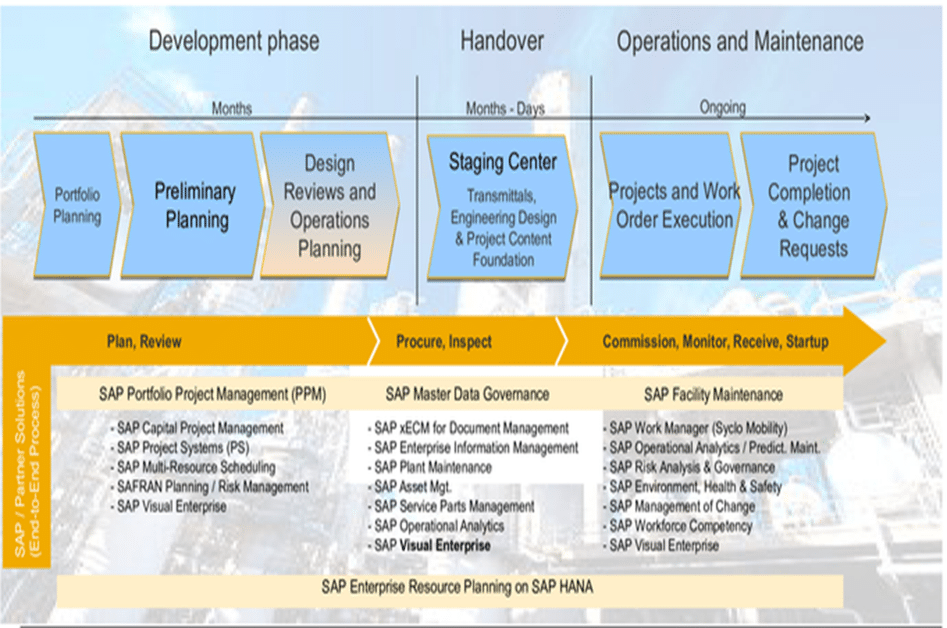
SAP solutions portfolio for oil and gas address potential activities during design and build phase, through collaborating with suppliers, maintaining design information and 2D/3D drawings, as well as budget and project planning and execution
See: SAP Capital Planning Solutions and SAP Capital Portfolio and Project Management
4.2 Engineering Data Handover and Master Data Management
Equipment manufacturers leave behind enormous amount of information in all sorts of formats. Most of this data are very crucial in building a resilient master data repository. Acquiring engineering data and equipment manufacturer handover is a typical requirement for a Greenfield refinery.
SAP in collaboration with our partners, has greatly simplified the challenge of asset master data management by adding a suite of pre-configured master data governance (MDG) data objects for enterprise asset management. These objects are built upon the SAP Master Data Governance platform. The enterprise asset management extension includes preconfigured data structures, industry templates, best practices, workflows and user interfaces for EAM data objects.
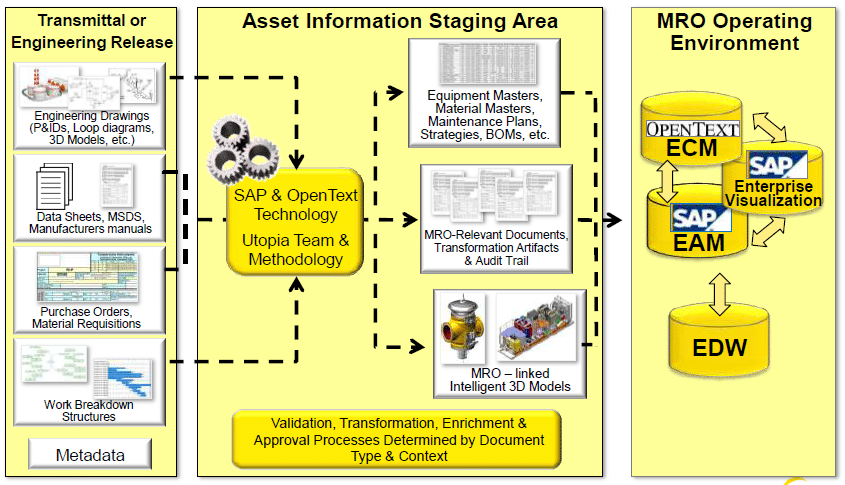
Maintenance managers working in process industries or in EPC companies are always under enormous pressure to ensure their plant’s equipment and machinery is working at an optimum level, which requires timely maintenance. But due to disparate systems, or missing or incomplete operators’ manuals, drawings and other information, maintenance can be a difficult challenge.
SAP Asset Intelligence Network, or AIN, is meant to solve some of these issues. AIN brings together companies, OEMs and service providers on a secure cloud platform to collaborate on all aspects of maintenance management

SAP 3D Visual Enterprise supports over 100 3D and 2D file formats, including Autodesk and Bentley formats. This allows our customers to amplify the value of (Building Information Management) BIM tools such as Intergraph SmartPlant 3D, Aveva PDMS, and others by re-purposing BIM data into a lightweight 3D format with full topology and attribution. The SAP lightweight 3D model can be enriched with EAM master data.
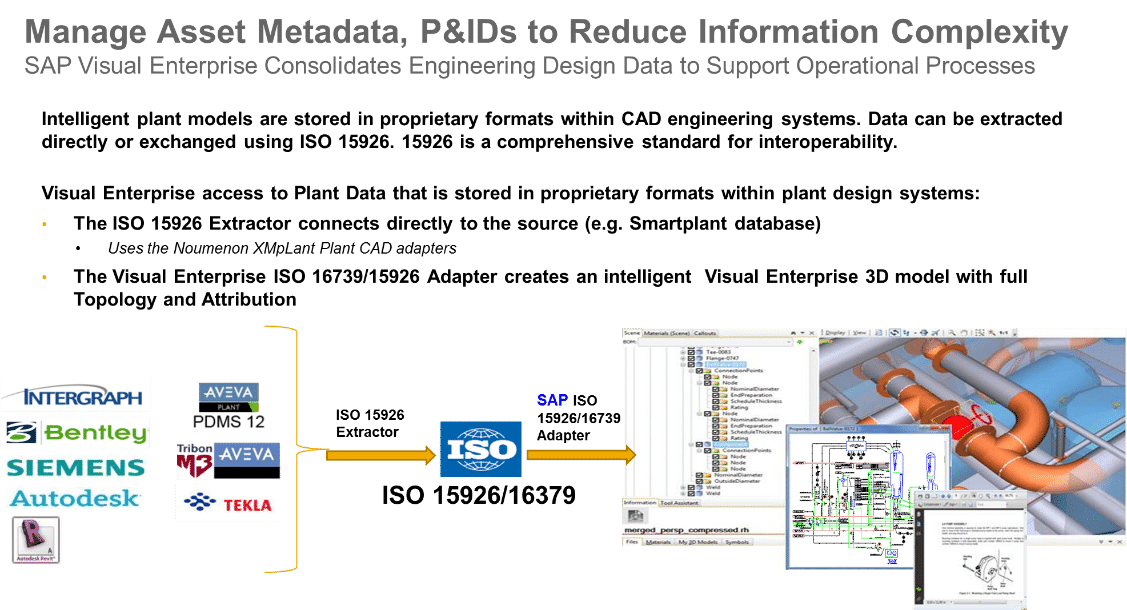
See: SAP Master Data Governance , SAP Master Data Governance for Enterprise Asset Management and Asset Information Management
4.3 Workforce Acquisition, Onboarding, Competencies Performance Management and Career Management
“Today’s workforce is more ‘blended’ than ever before,” said Christopher J. Dwyer, research director of Ardent Partners, a leading research and advisory firm. “Nearly 35 percent of the total global workforce is comprised of nonemployee talent, with that figure expected to grow steadily in the years ahead. As such, it is critical for businesses to develop ‘total workforce management’ programs that can effectively manage all enterprise talent under a single, centralized banner of systems and capabilities. ‘Total workforce management’ can revolutionize how both traditional and nontraditional talent is managed by improving visibility into total enterprise talent (regardless of its source) and enabling superior alignment of business needs and projects with required skill sets and expertise. Integration of contingent workforce and human capital management systems is an ideal ‘first step’ in building this type of program.”

Typically, a Greenfield refinery would require significant effort for staffing full time as well as contingent staff. The process spans all Human Capital Management activities from recruiting through onboarding (or cross boarding if staff are transferring between subsidiaries or sister companies), to career and performance management. SAP Total Workforce Management lets you optimize workforce planning, performance, and safety. Collaborate with internal and external suppliers. Share best practices to improve safety, performance, and profitability
See: SAP Total Workforce Management and Workforce Competency
4.4 Quick Time to Value, Agility, Reliability and Scalability
40+ years of industry experience are accumulated in industry best practices. SAP and SAP Partners utilize industry best practices and template based implementations to reduce risk and shorten implementation.
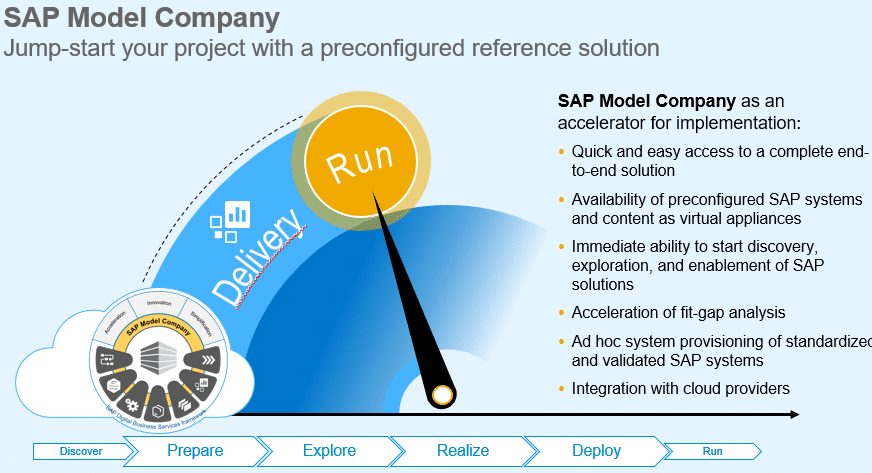
To move forward with speed and agility, it helps to focus on live digital data, instead of Big Data, and combine solution know-how and industry-specific process expertise with data analytics so that the right digital reference architecture is defined and delivered. In that context, we believe that a model company approach is very relevant to enable you to transition from your current state to digital. Model companies represent the ideal form of standardization for a specific line of business or industry. They are built on existing SAP solutions using best-practice content, rapid prototyping solution packages, and additional content from customer projects, They provide a comprehensive baseline for rapid, customer-specific prototypes, cloud demos, and quick-start implementations

See: SAP Best Practices
4.5 Make Best Use Out of Equipment Manufacturer Latest Technologies
Today’s modern systems include additional features not found in legacy systems, such as embedded advanced process control, statistical monitoring, smart device monitoring, asset health monitoring and more. Field instruments that are equipped with smart diagnostics can alert key maintenance, operations or safety personnel about asset problems in real time before they fail or cause abnormal operation.
The diagnostics can identify the root cause of the troubled asset, so maintenance can effectively correct the problem. This same root cause predictive diagnostic capability can be utilized to identify and plan for a smarter turnaround by repairing only the assets requiring work.
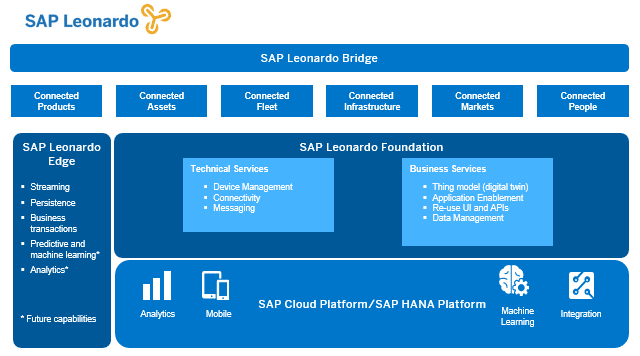
The SAP Leonardo portfolio empowers Live Business by connecting the emerging world of intelligent devices with people and processes to achieve tangible business outcomes. SAP Leonardo reaffirms an innovative value proposition, extending from SAP’s enterprise core into automation and intelligence at the edges where IoT data is created. SAP Leonardo offers intelligent IoT applications, business services for development, technical services for processing high-velocity data and an intelligent edge to process information at the device level. SAP Leonardo combines SAP’s unique strengths, including 40+ years of business process knowledge in oil and gas and leadership in Big Data management
See: SAP Leonardo: Innovation Portfolio
Industry-leading process, manufacturing and utility companies use OSIsoft’s PI System to capture operational data in real time and provide real-time operational insights. Over 1.5 billion sensor-based data streams gathered from 17,000 sites across 125 countries are managed by the PI System. Industrial enterprises can now combine and leverage business and operational data within the SAP HANA platform to help improve process efficiencies, asset health, energy utilization, safety and quality
See: SAP’s Connected Operations Integrate Historian Data to Improve Asset Performance (ARC Insights)
4.6 Starting Fresh, Digitize Business Processes not Existing Problems
SAP enables Greenfield digital refineries to utilize state of the art software technologies combined with industry best business practices to efficiently manage both core and innovative business processes. Energy leaders are investing in digital capabilities that support their strategy and will enable them to participate in a digital energy network.
This network will give all participants a platform for driving efficiency, accelerating energy innovation, and developing new business models.
SAP supports the move to energy network participation with the SAP Digital Business Framework – proven framework for developing a digital strategy. It covers the vital five pillars of a digital strategy:
1. A focus on the customer/stakeholder experience across all channels
2. Supplier collaboration across all spend categories (for example, direct, in-direct, services, commodity, and expenses)
3. Core business processes that are simplified and networked (for example, engineering, operations, supply chain, asset management, and finance processes)
4. Workforce engagement that includes both employees and contractors across the full employee lifecycle
5. Assets and the Internet of Things to drive real-time insights from connected and increasingly autonomous devices and assets
ROI drives this significant phase of the transition to digital. It’s not about any single one of the five pillars in isolation, but rather how they all interconnect to achieve business outcomes.
At SAP, we use design thinking as our key method during the reimagining phase. Design thinking helps you define what can be converted from your business strategy and customer needs into customer value and market opportunities.
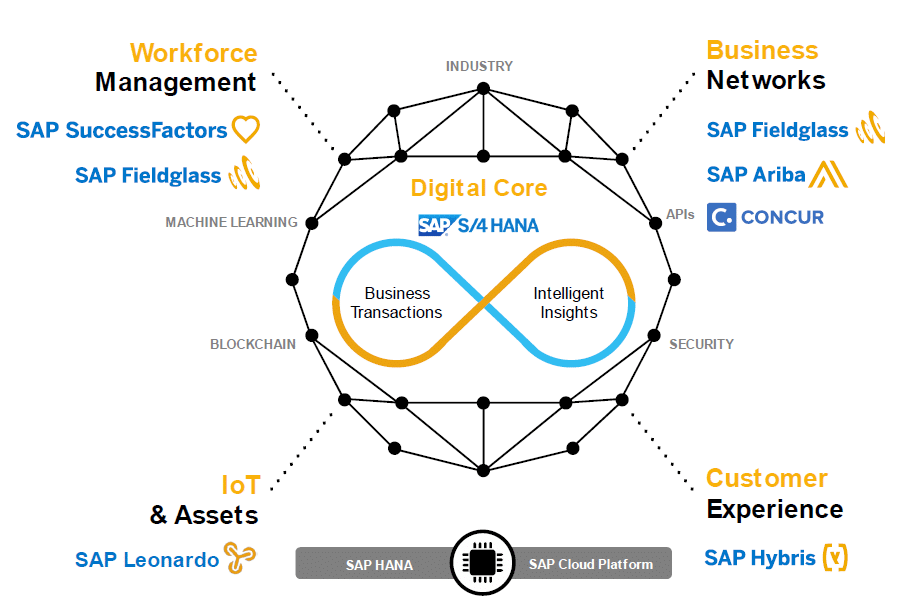
Smart operations and maintenance of gas plants, refineries, and terminals, and other assets is essential for cost efficient, compliant, and safe energy production, particularly in complex and hazardous production environments.
Using asset information and maintenance solutions together with integrated predictive analytics, companies can use sensor data to proactively monitor asset health. This kind of smart, digitally integrated asset management can be extended through energy networks to support automated allocation of spare parts, work, and logistics services. And by combining asset, planning, and financial data, they can analyze it and make decisions based on a holistic understanding of the impact of maintenance decisions.
Digital energy companies will improve machine-to-machine collaboration and provide simulations – for example, of asset repair procedures. And by delegating business processes from people to machines, companies will need fewer, yet higher skilled, workers who can orchestrate complex systems.
Digital energy companies will require effective and adaptive digital communication both within their organization and between their assets, workforce, customers, service providers, and all other stakeholders. Real-time digital information on the right devices will be a critical factor for the digitally-enabled worker to build and run the digital refinery of the future.
See: Maximize ROA with superior enterprise asset management (EAM), Procure to Pay and Business Network and SAP Predictive Maintenance
5. Taking the Right Decision – Best of Breed Verses Integrated End to End Digital Core
Greenfield refineries would potentially have to choose between the best of breed business systems and integrated business system options. This section highlight the differences between the two approaches.
5.1 Best of Breed – Manage Integration Not Business
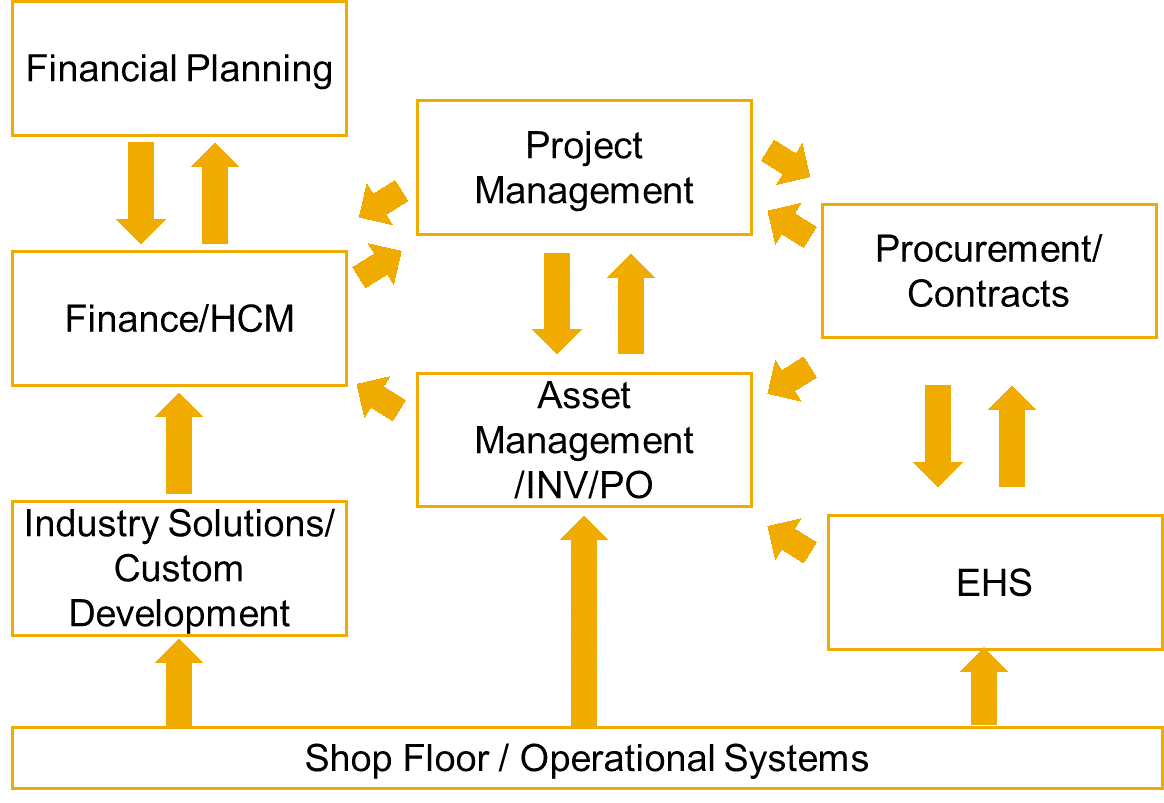
Under different conditions and for different reasons -mostly around being historically comfortable with specific solutions, new refinery owners will adopt the best of breed approach. That is, each department or function will adopt the solution that they are comfortable with. In such scenario each department will potentially be happy with what they have however on the strategic level such approach generates lots of technology and logistics challenges. Efforts are poured into maintaining integration across various solutions instead of continuous process enhancements and innovations. Refineries become considerably less flexible in responding to industry and market dynamics in such context.
With no real time integration between Production Management, Asset Management and Financial Management, real-time product/unit based margin analysis is almost impossible or significantly inaccurate. Same applies to cross departmental reporting, budget analysis, forecasting and simulations.
Refineries taking this approach usually ends up facing considerable data integrity issues resulting from having multiple copies of data maintained in several solutions/databases.
For every new requirement and in order to address operational pains, owners and operators develop additional solutions (silos) that would potentially replicate considerable part of data and add more integration points that in turn escalate complexity and make scalability and flexibility much more challenging.
Disadvantages can be summarized as follows:
- Multiple solutions (silos), multiple vendors and multiple data bases/technology stacks
- Multiple integration points some of which are bidirectional
- Interoperability constraints and integrations revisited with upgrades
- Adding a new silo with every new requirement
- Data integrity challenges
- Separate transactional and analytical instances
- Sophisticated corporate reporting with lots of manual entries
5.2 Integrated Business Applications – Real Time Actionable Insights
Imagine you have all your operational data maintained within an ultra-swift digital core. You don’t have to worry about integrating your asset operational data to your finance system or investing lots of time consolidating crude and products inventory in batch mode to your financial system. Inquires like asset life time cost, products margin analysis, budget control, forecasting and simulations become native functionality and in real time.
Moving some functionalities to the cloud brings lots of benefits to refineries. Workforce and spend management cloud solutions rationalize capital investments by significantly reducing need for infrastructure investment as well as IT resources for solution housekeeping. Short deployment period provides quick time to value and significantly lower adoption risks
Data integrity issues are significantly reduced especially if the proper engineering data handover was carried out using the SAP approach outlined in this blog.
The integrated digital core approach gives refineries much better scalability and flexibility in responding to industry and market challenges. As an example, we have recently co-innovated -with a refinery customer, a solution to reduce outages due to corrosion in crude processing units.
The solution was built around the high processing speed of the In-memory digital core, IT-OT connectivity through SAP Leonardo together with predictive and machine learning capabilities of the digital core and self service analytics. Through a POC customer managed to find a correlation between the levels of chemicals need to be injected to avoid corrosion and the conditions/substances that are potentially causing it. This allowed customer to maintain the right conditions to minimize corrosion which translates into longer unit life time and higher refinery throughput.
Advantages can be summarized as follows:

- Integrated end-to-end industry vertical solution and simplified technology stack
- Agile digital core with out of the box integration
- No interoperability issues and upgrades are much simpler
- New requirements are either addressed by additional modules or custom extensions using the existing digital core
- Single source of truth eliminates data integrity challenges
- Analytics run on top of transactional data
6. Integrated End to End Digital Core – Greenfield Refinery Sample Architecture

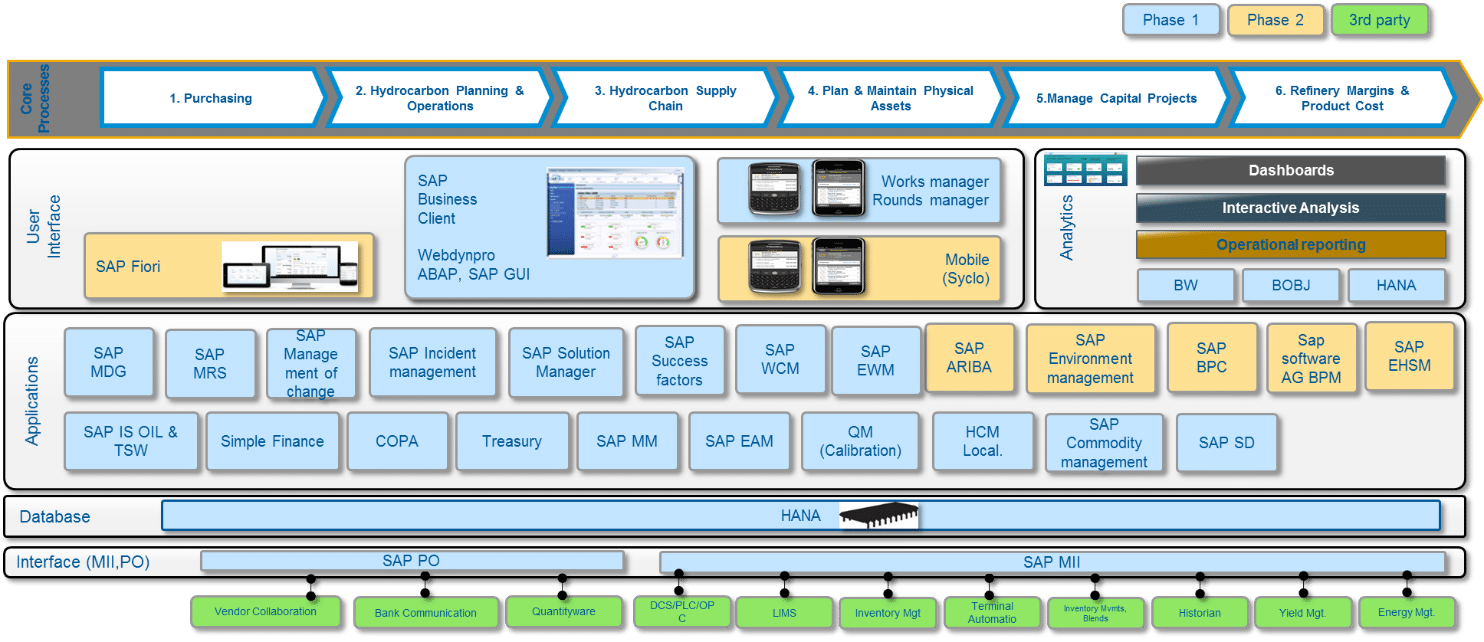
7. Conclusion
SAP underpins the digital refinery of the future with the Digital core, Business Networks, Digital Supply Chain and the Internet of Things. SAP will bring the simplification, innovation, and acceleration required to support the Greenfield refinery journey.
In the digital economy, simplification and business innovation matters more than ever. SAP has a broad range of services to cover the end-to-end digital refinery journey, ranging from advising on a digital innovation roadmap and plan to implement with proven best practices to the ability to run across all deployment models and ultimately optimize for continuous innovation across your digital journey.
We at SAP believe that our digital core integrated end to end industry specific offering is the perfect choice for Greenfield as well as Brownfield refineries who are after acceptable TCO and end to end real time actionable business insights.
Oil and Gas companies adopting an integrated system with a digital core are destined to realize tremendous potential benefits on four frontiers, Strategy Enablement, Business Benefits, Risk Management as well as IT Benefits and TCO.

*Benefits are based on early adopters of SAP S/4HANA or conservative outside-in benefits due to moving from a traditional ERP to enhanced SAP S/4HANA + LoB/cloud capabilities. As each enterprise is at a different level of maturity, we recommend working with you to determine the value proposition for your enterprise
7.1 Proof Point: SASREF: Taking Leadership in the Oil and Gas Industry to Transform Itself into a Digital Refinery
Saudi Aramco Shell Refinery Company (SASREF) operates a large oil refinery in Saudi Arabia. SASREF aspires to achieve best-in-class performance safely while maximizing profitability, with a commitment to its people and its community. In early 2014, SASREF was looking to define a vision to streamline and transform the company into a future-proof business, and it turned to SAP solutions.(4)
The vision was to gain complete visibility into operations, making the business more flexible, agile, and responsive. To turn this vision into reality, SASREF and SAP established the Tamkeen program. Through Tamkeen, the company rejuvenated its IT infrastructure and achieved many industry-leading innovations like visibility into unit-wise product costing based on actual material flows and a machine vibration management solution enabled by integration between IT and operational technology. The result is that SASREF can now respond to rapidly changing industry dynamics to improve its profitability and sharpen its competitive edge.
SASREF realized the following benefits:
- Increased savings with a Customer Center of Expertise organization
- Greater asset utilization and control of shutdowns
- Lower spend and total cost of ownership by streamlined procurement, optimal use of SAP software, less customization, and legacy sunset
- Native integration of SAP solutions for lower interface cost and simpler application lifecycle management
- Unit level Product profitability visibility and control in real time
- Improved On-time payments to suppliers
- 100% real time tracking of inventory movements and expenses for projects
8. Appendix
Resources/References
Articles:
- Oil Refining Capacity Set To Surge, But Can It Boost Oil Prices?
- Envisioning a “future-proof” refinery of the future: Marcelo Carugo, Director, Refining Solutions
- Refinery operations gain from advances in digital automation
- SAP Whitepaper: The Digital Oil and Gas Company
Links:
- SAP.com
- SAP for Oil and Gas
- The Value of SAP HANA in Oil and Gas
- Capital Planning
- Capital Portfolio and Project Management
- Hydrocarbon Logistics
- Hydrocarbon Supply and Distribution
- Hydrocarbon Processing Visibility
- Hydrocarbon Supply Chain Solutions from SAP
- Operational Integrity
- Asset Integrity Solutions
- Environment, Health, and Safety
- Maximize ROA with superior enterprise asset management (EAM)
- Asset Network
- SAP’s Connected Operations Integrate Historian Data to Improve Asset Performance (ARC Insights)
- SAP Predictive Maintenance
- Data Science and Machine Learning in the Internet of Things and Predictive Maintenance
- SAP Master Data Governance
- SAP Master Data Governance, Enterprise Asset Management Extension
- Keep Your Oil and Gas Assets Productive with Effective Master Data Governance
- SAP Leonardo: Innovation Portfolio
- Risk Analysis and Governance
- Procure to Pay and Business Network
- Workforce Competency
New NetWeaver Information at SAP.com
Very Helpfull
